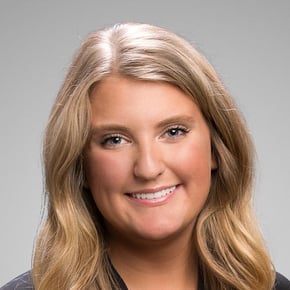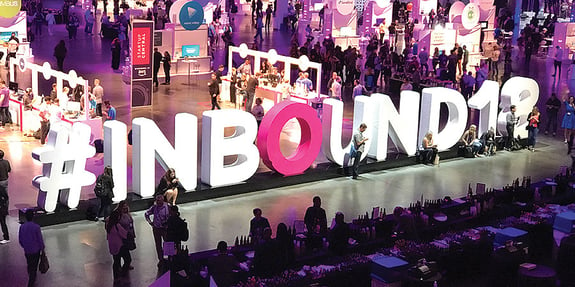I arrived in Boston for INBOUND 2018 feeling all the feels — excitement, nervousness, eagerness, slight intimidation, fascination, and optimism. Like I said, all the feelings.
INBOUND is a community of people who are passionate about marketing, selling, and delighting customers in an inbound way. And as a newbie to the conference, I was excited to be a part of this creative and inspiring community but, I was slightly worried about my tendency to be a little reserved.
You see, this was the perfect opportunity to learn and share with people from all over, but to do that, it meant I had to talk to them. I’ve always been a little shy and talking to new people gives me slight anxiety. Don’t get me wrong; I’m happy to have the conversations — I’ll just need to take a second to talk myself into doing it. But hey, that’s what makes me human, right?
The answer is yes, 100% right, preach, shout it from the rooftops, and without a doubt! Okay, this might be a little over the top but it’s true, it’s attributes like this that make us who we are. Our personalities, pet peeves, experiences, and even our fears and failures make each of us unique.
Now, you may have already seen this coming but, as I made my way through the sessions at INBOUND, this same idea kept coming up. We’re all unique; we’re human. And further to that point, people like to be treated like people.
This might not seem like a crazy idea. I mean most of us are aware that people don’t like being treated as if they aren’t a human being, right? The crazy part of this idea comes into play when you start talking about bringing the “human” back into a company’s brand, marketing, and sales.
Tell Your (Real) Story – Not the One You Think People Want to Hear
Everyone has a story. Everyone has experiences that make them who they are today. Companies are no different. It doesn’t matter if it’s the good, the bad, or the ugly — they all have shaped the company into what it is today. Sharing that story with the world is okay.
Brands (and people for that matter) often feel the need to cherry-pick their story to showcase the best version of themselves. And believe me, I understand the value these types of stories can have. But, consider for a moment a story that reveals where you and your company have come from — the real backstory. By talking about the adversity you’ve faced, and what you did with those lessons along the way gives you some serious street cred. It allows people to relate to something.
In the session “Stop Hiding Behind Your Logo! How to Humanize Your Brand Through Your Origin Story” by Marc Ensign, he talked about how people often approach their stories by thinking of them as just that, their story. But we have to consider it as something more, and that’s where Ensign makes an invaluable point — “If your story doesn't add to my story, it will never be OUR story.” *Que all the light bulb and aha visuals.*
Like Marc said, “people buy from companies but fall in love with humans.” They are more likely to buy from you (and even pay more in some instances) when they feel loyal to your brand and can connect to your story. So don’t be afraid to it — tell the mountains you’ve climbed, the cracks in the sidewalk you’ve tripped over, and what you’ve learned from each of them along the way.
Own Your Mistakes. (Because if You Don’t Then Who Will?)
To err is human. It’s inevitable, something will go wrong, and that’s okay. It’s like Dharmesh Shah said in his keynote, “Just say sorry, be sorry, and make it better.”
We often try to hide what went wrong or cover up a mistake we made because it can be challenging to admit faults. Trust me; I’m right there with you — just ask my friends. However, no matter how difficult, owning up to a mistake and being honest will always work out better for you. In fact, it can be proven with data; Shah dropped this statistic during his presentation, 96% of people would continue to buy from a company that screwed up but apologized and made it right.

You might be asking what does this look like in real life? Don’t worry I have that covered — let’s take a look at another example Dharmesh Shah provided.
Back in February of this year, KFC in the U.K. ran out of chicken. This seems almost unimaginable, a chicken tycoon running out of their most prized product, chicken. But KFC handled the misstep perfectly. The creative elements for this campaign are filled with humor but more importantly the copy they included seals the deal. KFC took out a full-page ad that stated the following “A chicken restaurant without any chicken. It’s not ideal. Huge apologies to our customers. It’s been a heck of a week, but we’re making progress, and every day more and more fresh chicken is being delivered to our restaurants. Thank you for bearing with us.”
They did it; they owned their mistake! They didn’t try to hide the elephant in the room; they didn’t try to blame someone else to make it seem like it wasn’t their fault. They said their apologies and worked to make it better.
This isn’t rocket science, and that’s good news. It means we all can implement this; we just have to step up to the plate. Heck, you can even take it a step further and start creating content based on negative questions you receive or issues that arise. This allows you to lead the conversation around them. You now are the one talking about all the negative things that could be discussed in your industry, but now you can help people understand why it happens, what you do to prevent it, and you’ve now humanized another section of your company — you’re not afraid to say what needs to be said.
Be True to Who You Are
We live in a world surrounded by technology, but I don’t have to tell you that. What you might not know is on average people spend 6 hours a day on their phones, or between the years of 13-79 people spend five years on social media, or we check our phones 12 billion times every day in the U.S. This means human connections are more important than ever.

It also means empathy and humanity have to be at the center of business, a point made by Erica Keswin at her breakout session, “BRING YOUR HUMAN TO WORK: Smart Companies Honor Relationships.” One of the key points she discussed is the importance of knowing who you are and letting your values drive your business.
Most companies have values, but one common mistake many brands make is having too many. If you overload yourself with too many values, it won’t allow you to differentiate yourself in the marketplace. A good rule of thumb is to aim for 4-6. However, don’t let yourself fall into the trap of thinking just having values for your brand is enough.
According to a Gallup research report in 2015, companies deliver on their brand promises only half of the time. It’s critical that you allow your values to guide your company in everything it does.
A great place to start is with employees. A study by Gallup shows only 42% of employees overall strongly agree that they know what their organization stands for and what makes it different from its competition. Your employees and co-workers can be one of your most influential brand ambassadors.
Alex Williamson, Chief Brand Officer for Bumble, presented a breakout session called, “How to Build a Brand with Kindness” during which she was asked the question, “how does Bumble get their new hires to buy into the company voice and values?” Her response was rather simple – ”find people who are diehard in love with what they are doing.” Strong values are important, they not only give people something to relate to but help to humanize your brand in a world that is so focused on all things tech.
Now that I’m back at my desk after a week at #INBOUND18 I have to admit, I still feel all the feels, and I’m okay with that because this time they’re all good feelings. I’m excited to start implementing new ideas here at TANK New Media, I’m curious how we can look at things differently, and intrigued by the idea of letting our human show more regularly!
Interested in what implementing new ideas similar to these might look like for a brand? Learn more about how TANK New Media helped The Mutual Fund Store realign their brand identity to better represent the company’s goals moving forward and better articulate their new personalized approach to investment advice.
Read more articles by Taylor.




